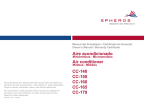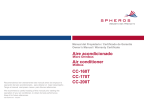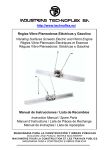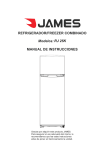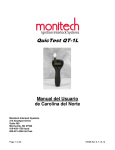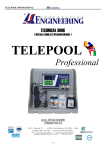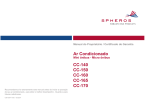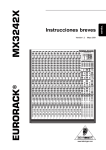Download Manual Aire acondicionado Spheros CC 145T
Transcript
Aire Acondicionado Miniómnibus - Microomnibus Air Conditioner Minibus - Midbus Manual del Proprietário / Certificado de Garantía Owner’s Manual / Warranty Certificate Recomendamos leer atentamente este manual antes de empezar la operación del aire acondicionado, para obtener el mejor desempeño . Tenga el manual siempre en manos para futuras referencias. We recommend a careful reading of this manual prior starting the operation of your air conditioner, to obtain its best performance. Keep it for future references.. CC 145T Término de Garantía Spheros 1 - TÉRMINOS DE GARANTÍA SPHEROS 7 – L A GARANTÍA PERDERÁ SU VALIDAD: LA SPHEROS CLIMATIZAÇÃO DO BRASIL S/A garantiza sus productos por un período de un año, contados a partir de la fecha de instalación del equipo, que consta en el cuerpo del certificado de garantía. Si el equipo es instalado por un tercero la Spheros garantiza solamente el producto y no la instalación del mismo. Ninguna reivindicación será acepta si el vehículo continua siendo usado después de constatado el defecto, mismo que haya falta de piezas, atraso en el transporte o cualquier otro incidente. a) Si la instalación o utilización del producto estuviera en desacuerdo con las recomendaciones técnicas de la Spheros. b) Si el producto sufrir cualquier daño provocado por accidente, agentes de la naturaleza, malos tratos, o aún alteraciones y reparos realizados por personas no autorizadas por el fabricante. c) Si el certificado de garantía o el número de serie del producto estuviera adulterado, rasurado o damnificado. d) Si defectos y desempeño insatisfactorios son provocados por la utilización de piezas no originales y en desacuerdo con las especificaciones técnicas de la SPHEROS. 1- La garantía tendrá validad por el plazo arriba especificado, empezando a partir de la fecha de instalación del equipo, mismo que la propiedad del producto cambie de dueño. 2- Durante el período estipulado, la garantía cubre totalmente la mano de obra y piezas para reparos de defectos debidamente constatados como siendo de: fabricación del equipo; falla prematura de material y defectos de componentes utilizados en la fabricación del mismo. 3- Solamente un técnico de la red de servicio autorizado Spheros está habilitado a reparar defectos cubiertos por la garantía. 4- El reparo o sustitución de piezas defectuosas, realizado por el servicio autorizado, no tendrá débito de piezas y/o mano de obra al cliente. 5- La aprobación de la garantía está condicionada al analice técnica del defecto presentado en el componente y a condiciones operacionales a que el equipo fue sometido. 6- La garantía de componentes utilizados en montaje de equipos Spheros, que poseen red propia de asistencia técnica, será obtenida junto a su red, mediante la presentación del certificado de garantía Spheros. Como ejemplo el caso del alternador, que debe ser encaminado para la red Bosch. 8 – LA GARANTÍA NÃO CUBRE: a) Traslado del producto para reparos. Si el consumidor desea ser atendido en sus instalaciones, quedará a criterio del Servicio Autorizado la cobranza o cortesía de la tasa de visita. b) La asistencia al consumidor, gratuita o remunerada, en ciudades que no poseen Servicio Autorizado. Así los costos con traslados son de total responsabilidad del propietario. c) Falta de mantenimiento preventivo, conforme descrito en este manual, en el ítem mantenimiento preventivo. d) Revisiones, ajustes y limpieza, pues estas informaciones constan en el manual del propietario. e) Piezas que sufrieron desgastes considerados naturales. Son considerados componentes de desgastes naturales: correas, filtros en general, aceites lubrificante, relees y fusibles. f) Pérdidas o lucros cesantes ocasionados por la parada del vehículo debido al mal funcionamiento del equipo de aire acondicionado. LA GARANTÍA SOLAMENTE SERÁ VALIDADA MEDIANTE LA PRESENTACIÓN DEL CERTIFICADO DE GARANTÍA ORIGINAL. 3 Spheros Warranty Terms 1 - SPHEROS WARRANTY TERMS 7 – THE WARRANTY LOSES ITS VALIDITY: SPHEROS CLIMATIZAÇÃO DO BRASIL S/A guarantees its products for the period of one year, counted from the equipment installation date, which is stated on the cover of the warranty certificate. In case a third party installs the equipment, Spheros guarantees only the product and not its installation. No claim will be accepted if the vehicle continues to be used after the evidence of defect, even if there is lack of parts, delays in transportation or any other incident. a) If the installation or use of the product is not in accordance with the Spheros technical recommendations. b) If the product suffers any damage caused by accident, nature agents, misuse, or yet alterations and repairs performed by any other than the manufacturer’s authorized technicians. c) If the warranty certificate and/or the serial number of the product is adulterated, overwritten or damaged. d) If defects or unsatisfactory performance are caused by the use of not original spare parts and in disagree with the technical specifications from SPHEROS. 1- The warranty will be valid for the period above specified, counted from the equipment installation date made by the first buyer/consumer, even though the property has been transferred. 2- During the stipulated period, the warranty covers totally the workmanship and spare parts when repairing defects duly identified as being: equipment manufacturing; primary failure of material and defects of components used on its manufacturing. 8 – THE WARRANTY DOES NOT COVER: 5- The warranty approval is conditioned to the technical analysis of the defect presented on the components and operational conditions to which the equipment was submitted. a) Transportation expenses to the repair facility. In case the consumer decides to be attended in the same place the product operates, the collection or not of the visit tax will be the criterion of the Authorized Service. b) The attendance to the consumer, free or paid, in cities that do not have Authorized Services. Being thus the expenses with displacement are of total responsibility of the owner. c) Failure of proper preventative maintenance, according to the described in this manual, on the preventative maintenance item. d) Revisions, external adjustments and cleaning, therefore these information are listed on the owner’s guide. e) Parts that wear out naturally. Are considered components of natural wear out: belts, filters in general, lubricant oil, relays and fuses. f) Losses or losses of profits caused by the stop of the vehicle due to the not functioning of the air conditioning equipment. 6- The warranty of the components used on the assembly of the Spheros equipment, which have their own net of technical assistance, will be obtained from its own net, by presenting the Spheros warranty certificate. Having as example the alternator case, it should be forwarded to the Bosch net. THE WARRANTY WILL ONLY BE VALID BY PRESENTING THE ORIGINAL WARRANTY CERTIFICATE. 3- Only a technician from the spheros authorized net of services is qualified to repair the defects covered by the warranty. 4- The repair or replacement of defective parts, performed by an authorized service station, will not incur in any debit regarding parts and workmanship used. 4 Índice / Index 1 - INTRODUCCIÓN ...................................................................................................... 6 1 - IDENTIFICACIÓN DEL AIRE ACONDICIONADO..................................................... 7 2 - OPERACIÓN ............................................................................................................ 8 2.1 - INFORMACIONES GENERALES DE OPERACIÓN ......................................... 8 2.1.1 - ACCIONAMIENTO DEL CONDENSADOR .................................................. 8 2.1.2 - ACCIONAMIENTO DEL EVAPORADOR ..................................................... 8 2.1.3 - ACCIONAMIENTO DEL COMPRESOR ....................................................... 8 2.1.4 - SISTEMA DE PROTECCIÓN ....................................................................... 8 2.2 - OPERACIÓN DEL AIRE ACONDICIONADO - CONTROLADOR GLW 161 ..... 9 2.2.1 - MODO REFRIGERACIÓN ........................................................................... 9 2.2.2 - MODO VENTILACIÓN ................................................................................. 9 2.2.3 - PROGRAMANDO EL SET-POINT............................................................... 10 2.2.4 - FALLAS ....................................................................................................... 10 3 - DESCRIPCIÓN DEL EQUIPO ................................................................................. 11 3.1 - LOCALIZACIÓN DE COMPONENTES ........................................................... 11 3.2 - ESPECIFICACIONES TÉCNICAS.................................................................... 12 3.2.1 - COMPONENTES DEL EQUIPO ................................................................. 13 4 - MANUTENCIÓN PREVENTIVA ............................................................................. 14 4.1 - TABLA DE FRECUÊNCIA PARA MANUTENCIÓN PREVENTIVA ................. 14 4.2 - VERIFICACIÓN DE LA CARGA DE GAS REFRIGERANTE .......................... 16 EN EL SISTEMA LEYENDA ELÉCTRICA .............................................................................................. 17 5 - ESQUEMAS ELÉTRICOS ..................................................................................... 18 1 - INTRODUCTION....................................................................................................... 6 1 - AIR CONDITIONER IDENTIFICATION .................................................................. 20 2 - OPERATION .......................................................................................................... 21 2.1 - OPERATION GENERAL INFORMATION ........................................................ 21 2.1.1 - TURNING THE CONDENSER ON ............................................................ 21 2.1.2 - TURNING THE EVAPORATOR ON .......................................................... 21 2.1.3 - TURNING THE COMPRESSOR ON ......................................................... 21 2.1.4 - PROTECTION SYSTEM ............................................................................ 21 2.2 - AIR CONDITIONER OPERATION - GLW 161 CONTROLLER ....................... 22 2.2.1 - COOLING MODE ....................................................................................... 22 2.2.2 - VENTILATION MODE ................................................................................ 22 2.2.3 - PROGRAMMING THE SET-POINT ............................................................ 23 2.2.4 - FAILURES................................................................................................... 23 3 - EQUIPMENT DESCRIPTION ................................................................................ 24 3.1 - COMPONENTS LOCATION ........................................................................... 24 3.2 - TECHNICAL SPECIFICATION ........................................................................ 25 3.2.1 - EQUIPMENT COMPONENTS ................................................................... 26 4 - PREVENTATIVE MAINTENANCE ......................................................................... 27 4.1 - FREQUENCY SCHEDULE FOR PREVENTATIVE MAINTENANCE .............. 27 4.2 - VERIFICATION OF REFRIGERANT GAS LOAD IN THE SYSTEM ............... 29 5 - ELECTRICAL SCHEME ......................................................................................... 30 5 Introducciónes / Introduction INTRODUCCIÓN INTRODUCTION La Spheros desenvuelve sus productos preocupada en ofrecer a los pasajeros un ambiente confortable, buscando siempre la mejor condición de climatización. Spheros develops its products worried in offering to the passengers a comfortable environment, always looking for the best air conditioning concepts. Los equipos poseen simplicidad de operación y una gran precisión de control. Los sistemas con dimensiones optimizadas, garantiza una alta capacidad de resfriamiento con bajo nivel de ruido. The equipments are simple to operate and have great precision of control. The systems, with compact dimensions, guarantee a high cooling capacity with low noise level. Este manual fue desenvuelto con la finalidad de presentar aspectos importantes de funcionamiento, operación y manutención, para que se obtenga el mejor desempeño del equipo de aire acondicionado. This manual was developed with the purpose of presenting important functioning aspects, operation and maintenance, to obtain the best performance out of the air conditioning system. Para asegurar que el equipo tenga una larga vida útil y libre de problemas es imprescindible que las instrucciones de operación y manutención descritas en este manual sean seguidas y ejecutadas periódicamente. To ensure a long useful and problem free life to the equipment it is essential that the operation and maintenance instructions described in this manual are followed and performed periodically. Los controladores instalados por la Spheros y utilizados por el conductor están debidamente ilustrados y explicados en este manual. All controls installed by Spheros, which are used by the driver, are duly illustrated and explained in this manual. Es importante que el conductor lea atentamente las instrucciones de operación antes de iniciar la operación del equipo de aire acondicionado. It is important that the driver reads the operation instructions carefully before starting to operate the air conditioning equipment. La Spheros mantiene una red de servicio autorizado con herramientas, aparatos y un equipo de personas entrenadas para ejecutar cualquier tipo de manutención dentro de los padrones de calidad. Spheros keeps a net of authorized services with tools, equipments and a team of professionals trained to perform any type of maintenance within the quality standard. Agradecemos la preferencia por los productos Spheros. En caso de dudas entre en contacto con la red de servicio autorizado Spheros más próximo o comuníquese con el departamento de Asistencia técnica en la fabrica. Thank you for choosing Spheros products. In case of any doubt please contact the nearest Spheros’s authorized net of services or contact the technical assistance department.. 6 Identificación del Aire Acondicionado 1 - IDENTIFICACIÓN DEL AIRE ACONDICIONADO Es de fundamental importancia, en casos de pedidos de piezas de reposición, y demás correspondencias, que el cliente identifique el modelo del aire acondicionado, mencionando el número de serie, modelo y fecha de fabricación del mismo. Estas informaciones podrán ser encontradas en el Certificado de garantía del equipo del aire acondicionado y en la tarjeta de identificación (ver figura 1). En la tarjeta consta también el tipo de gas refrigerante utilizado y cantidad necesaria para el modelo. Informaciones referentes a aplicaciones como: N° de serie y modelo de carrocería; serie y modelo de chasis, también son importantes para la identificación de piezas que componen el equipo de aire acondicionado. Para identificación de la carrocería y del chasis los manuales de los mismos deben ser consultados. SPHEROS CLIMATIZAÇÃO DO BRASIL SA AV. RIO BRANCO NRO 4688 - B SÃO CRISTÓVÃO 95060-650 - CAXIAS DO SUL - RS - BRASIL Fone (54) 2101 5700 Fax 9540 2101 5747 E-mail: [email protected] Equipo Modelo.......: Codigo.......: No. Serie....: Fecha........: GAS Tipo.: R 134 a CC145T 100-00000-000 99999999999 00/00/00 Cd.:3,7Kg figura 01 * la cantidad de refrigerante puede variar de una aplicación 7 Operación 2 - OPERACIÓN 2.1.2 - ACCIONAMIENTO DEL EVAPORADOR 2.1 - INFORMACIONES GENERALES DE OPERACIÓN El control de velocidad de los ventiladores del evaporador es hecho automáticamente de acuerdo con la temperatura programada y la temperatura interna del coche. Los controladores de los equipos de aire acondicionado Spheros son normalmente instalados en el panel de la cabina del conductor. Son compuestos por un display y un teclado destinado a la operación del equipo. El display informa al operador el valor de la temperatura interna del vehículo. También es utilizado para visualización del status de la operación y programación de la temperatura del Set-point*. La temperatura interna es detectada por el sensor de temperatura ubicado en el retorno de aire del equipo. (ver iten 3.1). Importante: El equipo de aire acondicionado solamente funcionará con el motor del vehículo prendido. Recomendase siempre apagar el aire acondicionado antes de apagar el motor del vehículo. Obs.: Antes de encender el aire acondicionado verifique las condiciones de las correas del compresor localizado junto al motor del vehículo (ver iten 3.1). Cuando la temperatura interna llega próxima del set-point, la velocidad de los ventiladores es reducida y cuando la temperatura interna se aleja del setpoint, la velocidad de los ventiladores aumenta automáticamente. Para equipos instalados en coches utilizados en líneas urbanas, donde existe una necesidad mayor de refrigeración, la ventilación funciona solamente a velocidad alta. 2.1.3 - ACCIONAMIENTO DEL COMPRESOR El compresor trabaja solamente en el “Modo refrigeración”, y entrará en operación 10 segundos después de que el evaporador sea accionado. Por motivos de seguridad los controladores poseen una histerese de tiempo de 30 seg. para rearmar el compresor toda vez que él mismo se apague. 2.1.1 - ACCIONAMIENTO DEL CONDENSADOR 2.1.4 - SISTEMA DE PROTECCIÓN Los ventiladores del condensador, así como el compresor, solamente serán accionados cuando el equipo del aire acondicionado funcione en el “Modo Refrigeración”. Los equipos poseen un sistema eléctrico que monitora sus presiones de trabajo. Este monitoreo es hecho por presostatos**. Cuando ocurriera una falla en el equipo y las presiones de trabajo del sistema sufrieren una alteración, el controlador recibirá una señal de los presostatos y el display mostrará un código de falla (ver fallas en el iten 2 –Operación). Para seguridad del compresor el mismo será apagado inmediatamente. * Set-point – es el valor de temperatura deseado en el interior del vehículo, ajustada por el operador (conductor). ** Presostato – dispositivo de seguridad que protege los componentes del sistema del aire acondicionado contra altas y bajas presiones. Obs.: Las presiones son monitoreadas constantemente mismo si el aire acondicionado estuviera apagado. 8 Operación 2.2 - OPERACIÓN DEL AIRE ACONDICIONADO - CONTROLADOR GLW161 Al accionar la llave de ignición, el display, primeramente mostrará la versión del software del controlador, después mostrará la temperatura interna del vehículo. Antes de poner el motor en marcha el display mostrará la sigla AL (ver iten 2.2.4). 6 7 8 9 1 3 4 5 1 - Display numérico 2 - Tecla control de ventilación (VENT.) 3 - Tecla control de refrigeración (REFRIG.) 4 - Tecla (AUMENTA) 5 - Tecla (DISMINYE) 6 - Indicativo “modo refrigeración” 7 - Indicativo “modo automático” 8 - Indicativo “modo ventilación velocidad baja” 9 - Indicativo “modo ventilación velocidad alta” 2 2.2.1 - MODO REFRIGERACIÓN 1- Para encender el equipo presione la tecla (REFRIG). El “modo refrigeración” encenderá automáticamente en función de la temperatura interna del vehículo y de la temperatura ajustada. La operación del modo refrigeración será señalizada conforme información abajo. a) Indicativo (6) apagado informa que el “modo refrigeración” está apagado b) Indicativo (6) parpadeando informa que el equipo está trabajando en el “modo ventilación” c) Indicativo (6) encendido informa que el “modo refrigeración” está encendido. 2 - Para desactivar el “modo refrigeración”, presione nuevamente la tecla (REFRIG). Siempre que el sistema inicie en el “modo refrigeración” los ventiladores del evaporador empezarán en el “modo automático”. Pero, la velocidad puede ser alterada manualmente (ver iten 2.3.2). El accionamiento de los ventiladores del evaporador en el modo automático es hecho de acuerdo con la programación del set-point. 2.2.2 - MODO VENTILACIÓN El “modo ventilación” proporciona dos velocidades de operación: 1- Con el “modo refrigeración” desactivado presione la tecla (VENT) y el aire acondicionado funcionará solamente en ventilación. El indicativo (8) quedará encendido para informar que la ventilación está operando en velocidad baja. 2- Para que los ventiladores operen en velocidad alta, presione nuevamente la tecla (VENT). Esta función será informada por el indicativo (9) encendido. 3- Presionando una vez más la tecla (VENT) desactivará el “modo ventilación” 9 Operación Con el “modo refrigeración” activado la velocidad de la ventilación es normalmente automática, y será informada por el indicativo (7) encendido. Aunque la velocidad puede ser alterada manualmente, siguiendo los mismos pasos informados anteriormente. 4 - Para volver al control automático, presione la tecla (VENT) hasta que el indicativo (7) encienda, informando que la ventilación está en el modo automático. 2.2.4 - FALLAS Este controlador posee un sistema de monitoreo de fallas. Cuando ocurra alguna falla en el sistema del aire acondicionado, el display mostrará una alarma conforme información abajo. FALHA DESCRIÇÃO 2.2.3 - PROGRAMANDO EL SET-POINT Falla de presostato 1- Para ajustar el set-point presione una de las teclas (AUMENTA) o (DISMINUYE). La temperatura del set-poit aparecerá parpadeando en el display. Sensor de temperatura abierto 2- Para programar el set-point basta presionar la tecla (AUMENTA) para aumentar la temperatura o la tecla (DISMINUYE) para disminuir la temperatura, hasta encontrar la temperatura deseada. 3- Después de la temperatura deseada definida, el display continuará parpadeando por 5 segundos. Cuando pare de parpadear el mismo mostrará la temperatura interna del vehículo y la temperatura del set-point estará reprogramada Sensor de temperatura en corto Falla del alternador 1- Si ocurriera alguna falla de presostato, el display mostrará la alarma (HA) y el sistema apagará el compresor. Después de corregida la falla, el sistema aguardará 3 minutos para accionar nuevamente el compresor. 2- Como el sistema opera en función de la temperatura interna el controlador posee dos códigos de falla para monitorear el sensor de temperatura: a) Si el sensor de temperatura estuviera abierto el display mostrará (OP) b) Si el sensor de temperatura estuviera en corto circuito el display mostrará (SC) 3- Este controlador posee un parámetro para monitorear el alternador. Caso el alternador no estuviera cargando el display mostrará el código (AL). Importante: Al identificar cualquier falla en el sistema del aire acondicionado, el vehículo deberá ser encaminado a un puesto de servicio autorizado Spheros. 10 Descripción del Equipo 3 - DESCRIPCIÓN DEL EQUIPO El equipo del aire acondicionado Spheros, modelo CC145T posee designer que proporciona una perfecta integración con el vehiculo. Consiste en un equipo de techo, constituido por un módulo conden sador y un modulo evaporador, conectados a un compresor. 3.1 - LOCALIZACIÓN DE COMPONENTES Evaporador Condensador El compresor está ubicado junto al motor del vehículo. El producto utiliza gas refrigerante R134a, conforme ley de protección al medio ambiente. El sistema eléctrico está compuesto por una placa de potencia, ubicada en el evaporador que es comandada por un controlador electrónico ubicado junto al panel del conductor. Controlador El controlador recibe información del sensor de temperatura, que está ubicado en el retorno del aire del evaporador, y hace con que el equipo funcione buscando alcanzar la temperatura deseada en el interior del vehículo. (ver item 2) Obs.: El sistema eléctrico está conectado al alternador y baterías del vehículo. Compresor 11 Especificaciones Técnicas 3.2 - ESPECIFICACIONES TÉCNICAS FICHA TÉCNICA AIRE ACONDICIONADO GAS REFRIGERANTE Modelo Capacidad de refrigeración Tipo Cantidad CC-145T 45.000 BTU/hR R 134a 3,7 kg* EVAPORADOR Modelo de ventiladores Cantidad de ventiladores Volumen de aire Corriente nominal centrífugo 2 2040 m3/h 38 A CONDENSADOR Modelo de ventiladores Cantidad de ventiladores Volumen de aire Corriente nominal axial 2 5500 m3/h 32 A COMPRESOR EMBRAGUE Modelo (Tipo revolución) Deslocación Máxima rotación por minuto Aceite lubricante Cantidad de aceite SP 22 212 cm3 4500 RPM 027-00001-000 180 ml Tipo Voltaje eletromagnética 12 v 12 Componentes del Equipo 3.2.1 - COMPONENTES DEL EQUIPO 1 2 4 5 3 8 7 6 ITEM DESCRIPCIÓN CÓDIGO ITEM 1 Ventilador condensador 12” 24v 021-00021-001 5 Serpentin evaporador DESCRIPCIÓN 006-00090-000 CÓDIGO 2 Serpentín condensador 006-00089-000 6 Válvula de expansión 012-00004-000 3 Filtro deshidratador / mirrilla / tanque 012-00074-000 7 Sensor de temperatura 007-00042-000 4 Ventilador evaporador 12V 021-00020-001 8 Placa de relees GL-T043 12V 007-00001-000 13 Manutención Preventiva 4 - MANUTENCIÓN PREVENTIVA 4.1 - TABLA DE FRECUENCIA PARA MANUTENCIÓN PREVENTIVA Las acciones de manutención preventiva aquí descriptas, fueran consideradas para condiciones operacionales normales. Caso las condiciones sean de grande solicitación y contaminación ambiental, las acciones preventivas deberán ser mas frecuentes. REFRIGERACIÓN Instalar los manómetros y registrar las presiones, temperatura y condiciones de la línea de succión; Verificar la carga del refrigerante después de 15min de funcionamiento; Inspeccionar visualmente si hay marcas de desgastes y deterioración en tuberías y mangueras; Inspeccionar visualmente se hay señales de fuga de aceite e refrigerante; Verificar las presiones de abertura y cerramiento de los presostatos; Verificar la eficiencia del compresor. Mensual Trimestral Anual COMPRESOR / EMBRAGUE Inspeccionar visualmente si hay desgaste en la embrague; Verificar visualmente las condiciones, tensión y alineamiento de las correas del compresor; Limpiar el compresor y embrague; Verificar la resistencia y voltaje en la bobina (magneto). Mensual Trimestral Anual ESTRUCTURA Inspeccionar visualmente si hay piezas sueltas, dañadas o quebradas; Limpiar o sustituir el filtro del retorno del aire; Limpiar los drenes del condensador y evaporador; Limpiar el serpentín del condensador (utilizar jabón neutro); Limpiar el serpentín del evaporador (utilizar jabón neutro); Reapretar todos los tornillos del soporte del compresor y de la unidad observando los torques aplicados. Verificar la tapa del equipo. Mensual Trimestral Anual X X X X X X X X X X X X X X X X X 14 Manutención Preventiva ELÉCTRICA Mensual Trimestral Anual Verificar la secuencia del termostato (refrigeración / ventilación / calefacción); Verificar el alternador; Verificar el aprieto del cable de potencia en el alternador, fusible general, placa de relees y arranque Inspeccionar visualmente las correas del alternador observando la tensión, alineamiento y desgaste excesivo; Limpiar el alternador, verificar marcas de corrosión y las conexiones eléctricas; X Verificar el funcionamiento de las velocidades alta y baja de los ven. evaporador y el flujo de aire de los vent. evaporador e condensador X X X X X Limpiar la area donde está el controlador y el sensor de temperatura. Utilizar aire comprimido; Inspeccionar todos los cables y conexiones eléctricas, verificando daños y corrosión. X X Nota: Recomendamos utilizar esa tabla para desarrollar un plan de manutención periódica en sus vehículos.. IMPORTANTE: La limpieza del filtrador del retorno del aire localizado en el pasillo del vehículo y el serpentín del condensador localizada en la parte externa del vehículo, deberá ser realizada por el propietario con una periodicidad semanal, la no realización de estos servicios podrá ser encuadrada como negligencia, cancelando la garantía. La limpieza de los conductos del aire deberá ser hecha con una periodicidad trimestral y este tiempo puede ser reducido, dependiendo de la utilización del sistema del aire acondicionado, de la cantidad de personas transportadas y de la agravación sufrida por el medio adónde transita. Esta limpieza es de responsabilidad exclusiva del propietario del vehículo, a él le cabrá todo el ónus de la mala calidad del aire ofrecido a sus pasajeros. 15 Manutención Preventiva 4.2 - VERIFICACIÓN DE LA CARGA DE GAS REFRIGERANTE EN EL SISTEMA Después que el sistema del aire acondicionado esté funcionando por aproximadamente 5 minutos, con el embrague magnético acoplado y el motor del vehículo funcionando a una revolución mínima de 1500RPM, El refrigerante deberá fluir a través de la mirilla del líquido sin la formación de burbujas. Nota: Los refrigerantes no deben ser lanzados a la atmósfera (8, CFC directiva prohibitiva de Halon, 06/05/1991). 4.3 - CUIDADOS DURANTE EL INVIERNO Para prevención contra fugas en el sello del compresor, prenda el aire acondicionado por 15 minutos. Esa operación debe ser ejecotada dos veces al mes a una temperatura superior a 8°C. El tanque recibidor y los otros componentes del sistema del aire acondicionado deberán ser inspeccionados. Durante las actividades de manutención, una atención especial debe ser dada para señales de corrosión o algún daño mecánico. Todos los componentes que no estuvieran en perfecto estado deberán ser sustituidos por motivo de seguridad. Atención: En caso que ocurra un problema en el circuito de refrigeración, el mismo deberá ser reparado por un taller autorizado, o por un profesional capacitado. 16 Leyendas Eléctricas BATERIA E-BATTERY S-BATERÍA !M M +15 ( + PÓS IGNIÇÃO) E- + POS IGNITION S- + POS IGNICIÓN ! ALTERNADOR E-ALTERNATOR S-ALTERNADOR M PRESSOSTATO ALTA E-HIGH PRESSURE SW S-PRESSOSTATO ALTA GND E-GROUND S-TIERRA PRESSOSTATO BAIXA E-LOW PRESSURE SW S-PRESSOSTATO BAJA SENSOR EXTERNO E-EXTERNAL SENSOR S-SENSOR EXTERNO CHAVE IGNIÇÃO E-IGNITION KEY S-LLAVE DE IGNICIÓN SENSOR DE RETORNO E-RETURN SENSOR S-SENSOR DE VUELTA RELÉ E-RELAY S-RELAI SENSOR DE DUTO E-DUCT SENSOR S-SENSOR DEL DUCTO 1 2 VÁLVULA CALEFAÇÃO E-HEATING VALVE S-VÁLVULA DEL CALEFAC. PLACA DE RELÉS E-RELAY BOARD S-TABLERO DEL RALAIS CONVECTOR PISO E-CONVECTOR S-CONVECTOR TERMOSTATO ICE E-ICE THERMOSTAT S-TERMÓSTATO ICE COM 1 E-COMUNICATION 1 S-COMUNICACIÓN 1 SOLENÓIDE L. LIQUIDO E-SOLENOID LINE LIQUID S-SOLENOIDE L.LIQUIDO COM 2 E-COMUNICATION 2 S-COMUNICACIÓN 2 B BOMBA CALEFAÇÃO E-HEATING PUMP S-BOMBA CALEFACCIÓN COM 3 E-COMUNICATION 3 S-COMUNICACIÓN 3 EVAPORADOR MÉDIA E-AVERAGE EVAPORATOR S-EVAPORADOR MEDIO EMBREAGEM E-CLUTCH S-EMBRAGUE FUSÍVEL E-FUSE S-FUSIBLE EVAPORADOR BAIXA E-LOW EVAPORATOR S-EVAPORADOR BAJA CORRENTE MÁXIMA E-MAXIMUM CURRENT S-CORRIENTE MAXIMA RENOVAÇÃO DE AR E-FRESH AIR S-RENOVACIÓN DEL AIRE CONDENSADOR E-CONDENSER S-CONDENSADOR EVAPORADOR ALTA E-HIGH EVAPORATOR S-EVAPORADOR ALTA LÂMPADA EXCITAÇÃO E-EXCITEMENT LAMP S-EXCITACIÓN LAMP CORTINA DE AR E-AIR CURTAIN S-CORTINA DE AIRE POSITIVO DIRETO E- POSITIVE (DIRECT) S- POSITIVO (DIRECTO) EVAPORADOR E-EVAPORATOR S-EVAPORADOR OBS: Por tratar-se de equipamento elétrico com comutação de alta corrente, é indispensável que este seja instalado em local ventilado, não enclausurado, longe de tubulações de combustíveis ou inflamáveis, sob risco de incêndio/explosão. O equipamento não tem proteção contra água. Jatos ou respingos podem danificálo. 3 PS: Because this is an electrical control equipment with high commuting current, it is very important to be installed at a vented, open space, far from fuel/flammable material pipelines under the risk of fire/explosion. This equipment is not protected against water. Jets or splashes of water may damage it. The power screw must be tighten up so that the risk of fire because of a bad electrical contact may be avoid. PS: Como esto es un equipo eléctrico del control con la corriente que conmuta del colmo, es muy importante ser instalado en un espacio expresado, abierto, lejos del combustible/de las tuberías materiales inflamables, riesgo del fuego/de la explosión. Este equipo no se protege contra el agua. Los salpican del agua pueden dañarla. El tornillo de la energía debe ser aprieta para arriba de modo que el riesgo del fuego debido a un mal contacto eléctrico pueda ser evite. 17 Esquemas Elétricos 5 - ESQUEMAS ELÉCTRICOS CC 145T CON CONTROLADOR GL-W161 RL3 RL6 1 - CONECTA CONDENSADOR 2 - MOTOR COND. 1 F7 3 - MOTOR EVAP. V. BAJA 1 4 - CONECTA EVAP. V. ALTA F3 5 - CONECTA EVAP. V. BAJA 6 - SALIDA P/ CORTINA DEL AIRE F5 RL2 F1 RELEES 7 - N.C RL5 8 - MOTOR EVAP. V. ALTA 9 - EXCITACIÓN ALTERNADOR CN2 F4 F2 RL1 CN1 RL4 F8 F9 1 - N.C 2 - MOTOR COND. 2 MAXIMAS CORRIENTES ADMISIONES CN1: 3 - EMBRAGUE 4 - TIERRA RL7 RL8 J DEL AIRE - 0,5A@14VDC 5 - +12V 6 - N.C 7 - MOTOR EVAP. V. ALTA MAXIMAS CORRIENTES ADMISIONES CN2: 8 - MOTOR EVAP. V. BAJA 2 9 - MOTOR COND. 3 EMBRAGUE - 10A J 67,6 PS: Como esto es un equipo eléctrico del control con la corriente que c on muta del colmo, es muy importante ser instalado en un espacio expresado, abierto, lejos del combustible/de las tuberías materiales inflamables, riesgo del fuego/de la explosión. Este equipo no se protege contra el agua. Los salpican del agua pueden dañarla. El tornillo de la energía debe ser aprieta para arriba de modo que el riesgo del fuego debido a un mal contacto eléctrico pueda ser evite. ESTE DESENHO É DE PROPRIEDADE DE SPHEROS CLIMATIZAÇÃO DO BRASIL, É CONFIDENCIAL, NÃO DEVE SER DIVULGADO OU REPRODUZIDO SEMSEM EXPRESSA E ESCRITA PERMISSÃO DA COMPANHIA. THIS DRAWING IS PROPRIETY OF SPHEROS CLIMATIZAÇÃO DO BRASIL, IS CONFIDENCIAL, IT MUST NOT BE RELEASED OR COPIED WITHOUT WRITTEN AND EXPRESS PERMITION BY THE WCB. Part Name GL-T043 12V Date Drawing nº: 12/05/2009 007-00001-000 18 Esquemas Eléctricos (VM/1,5) (MA/1,5) (VE/1,5) (MA/1,5) GL-W161 (LA/1,5) (LI/1,5) (BR/1,5) (PR/1,5) 12V PS: GL-T043 RL2 RL1 RL5 RL3 RL6 RL4 RL7 * Dependendo da combinação CHASSI x ALTERNADOR, não ligar em paralelo. RL8 Depending on the combination CHASSIS x ALTERNATOR, do not connect in parallel. RL6 RL5 RL7 RL3 RL8 RL4 F2 30A F7 30A F5 20A F8 10A F3 20A F9 20A F4 20A (AZ/1,5) RL1 F1 20A (VM/25,0) RL2 (VM/25,0) Dependiendo de lacombinación ALTERNADOR x CHASIS, no atar en paralelo. (PR/25,0) ESTE DESENHO É DE PROPRIEDADE DE SPHEROS CLIMATIZAÇÃO DO BRASIL, É CONFIDENCIAL, NÃO DEVE SER DIVULGADO OU REPRODUZIDO SEMSEM EXPRESSA E ESCRITA PERMISSÃO DA COMPANHIA. THIS DRAWING IS PROPRIETY OF SPHEROS CLIMATIZAÇÃO DO BRASIL, IS CONFIDENCIAL, IT MUST NOT BE RELEASED OR COPIED WITHOUT WRITTEN AND EXPRESS PERMITION BY THE WCB. Part Name GL-T043 12V Date Drawing nº: 12/05/2009 007-00001-000 19 Air Conditioner Identification 1 - AIR CONDITIONER IDENTIFICATION It is extremely important, when ordering spare parts and sending other correspondences, that the customer identifies the air conditioner model, mentioning serial number, model and manufacturing date. This information may be found on the air conditioner's Warranty Certificate and on the identification tag. (See picture 1) On this tag it is also informed the refrigerant gas to use and necessary quantity for the model. * Information regarding the application such as: body serial number and model; chassis serial number and model, are also important to identify the spare parts that comprise the cooling equipment. To identify the body and the chassis, their manuals should be consulted. SPHEROS CLIMATIZAÇÃO DO BRASIL SA AV. RIO BRANCO NRO 4688 - B SÃO CRISTÓVÃO 95060-650 - CAXIAS DO SUL - RS - BRASIL Fone (54) 2101 5700 Fax 9540 2101 5747 E-mail: [email protected] Equipment Model........: Code.........: Serial nº....: Date.........: GAS Type.: R 134 a CC145T 100-00000-000 99999999999 00/00/00 Qt.:3,7Kg figura 01 * the amount of refrigerant may vary by application 20 Operation 2 - OPERATION 2.1.2 - TURNING THE EVAPORATOR ON This air conditioning model offers different options of control. Identify the controller visually and, after that, choose the compatible working instructions. The velocity control from the evaporator blower is automatically adjusted according to the temperature programmed and the temperature inside the vehicle. 2.1 - OPERATION GENERAL INFORMATION When the internal temperature reaches close to set-point, the velocity of the blower is reduced and when the internal temperature gets distant from setpoint, the velocity of the blower increases automatically. Spheros air conditioner controllers are usually installed on the driver's instruments dash. The controllers are composed of a display and a keyboard, used to operate the equipment. For equipment installed in city line vehicles, where the cooling need is greater, the ventilation works only on high velocity. The display shows the operator the number regarding the internal temperature of the vehicle. It is also used to visualize the operation status and programming the Set-Point* temperature. 2.1.3 - TURNING THE COMPRESSOR ON The internal temperature is detected by a temperature sensor located at the (see item 3.1) The compressor operates only on "Cooling Mode", and will start operation 10 seconds after the condenser is turned on. Important: the air conditioner will only work when the vehicle's engine is on. It's always recommended to turn the air conditioner off before turning off the vehicle. For safety reasons the controllers present a time histeresis set in 30sec. to restart the compressor every time it is turned off. Note: Before turning on the air conditioner verify the conditions of the compressor belts, located together to the vehicle's engine (see item 3.1) . 2.1.4 - PROTECTION SYSTEM The devices are equipped with an electrical system that monitors its work pressures. The pressure switch** performs this monitoring. 2.1.1 - TURNING THE CONDENSER ON The condenser engines, as well as the compressor, will only be activated when the air conditioner is working on the "Cooling Mode". * Set-point – is the temperature figure which is desired inside the vehicle, adjusted by the operator (driver). ** Pressure Switch – safety device that protects the components from the air conditioning system against high and low pressure. When a failure in the equipment occurs and the work pressures suffer any alteration, the controller receives a signal from the pressure switch and the display will show a failure code (see failures on item 2 – Operation). For safety reasons, the compressor will be automatically turned off. Note: The working pressures are constantly monitored even when the air conditioner is off. 21 Operation 2.2 - AIR CONTIDITONER OPERATION - GLW160 CONTROLLER- AIR REFRESHMENT When the ignition key is turned, the display will first show the controller's software version, right after, the internal temperature of the vehicle. Before the start the display will show the initials AL (see item 2.3.6) 6 7 8 9 1 1- To turn the equipment on, press the key (REFRIG). The "cooling mode" will be automatically on according to the internal temperature of the vehicle and the set temperature. The cooling mode operation will be shown according to the described below: a) Indicator (6) turned off informs that the "cooling mode" is off b) Indicator (6) blinking informs that the equipment is running on "ventilation mode" c) Indicator (6) turned on informs that the "cooling mode" is on. 2- To shut the "cooling mode " press once again the key (REFRIG) 3 4 2.2.1 - COOLING MODE 2 Whenever the systems initiates on "cooling mode" the evaporator's blowers will start on "automatic mode". However, the ventilation velocities may be changed manually (see item 2.3.2). The evaporator's blowers are activated, in the automatic mode, according to the set-point programming. 5 2.2.2 - VENTILATION MODE The "ventilation mode" provides two operation velocities: 1 – Numeric Display 2 – Ventilation control key (VENT) 3 – Cooling control key (REFRIG) 4 – Key (INCREASE) 5 – Key (DECREASE) 6 - Indicator "cooling mode" 7 - Indicator "automatic mode" 8 - Indicator "ventilation mode low velocity" 9 - Indicator "ventilation mode high velocity" 1- With the "cooling mode" shut, press the key (VENT) and the air conditioner will work only on ventilation. The indicator (8) will be on to inform that the ventilation is working at low velocity. 2- To have the blowers working at high velocity, press (VENT) key again. This function will be informed by having indicator (9) on.” 3- Pressing the key (VENT) one more time, the "ventilation mode" will be turned off. 22 Operation When the "cooling mode" on, the ventilation velocity is usually automatic, and will be informed by the indicator (7) turned on. However, the ventilation velocities can be altered manually, following the steps formerly described. 4- To return to the automatic control, press the key (VENT) until the indicator (7) turns on, which informs that the ventilation is on automatic mode. 2.2.4 - PROGRAMMING THE SET-POINT 1- To adjust the set-point press on of the keys (INCREASE) or (DECREASE). The set-point temperature will blink on the display. 2- To program it simply press the key (INCREASE) to increase the temperature or the key (DECREASE) to decrease the temperature, until the desired temperature is found. 3- After the desired temperature is selected, the display will keep blinking for 5 seconds. When it stops, it will show the internal temperature of the vehicle and the set-point temperature will be reprogrammed. 2.2.5 - FAILURES This controller is equipped with a failure system monitor. When any failure to the air system occurs, the display will show a message according to the table below: FAILURES DESCRIPTION Pressure Switch failure Temperature sensor open Temperature sensor in shock Alternator failure 1- If any failures occurs to the Pressure Switch, the display will show the message (HA) and the system will shut the compressor off. The system will wait for 3 minutes to turn the compressor on again, once the failure is corrected. 2- As the system operates according to the internal temperature, the controller possesses two failure codes to monitor the temperature sensor: a) If the temperature sensor is open, the display will show (OP) b) If the temperature sensor is in shock, the display will show (SC) 3- This controller possesses a parameter to monitor the alternator. In case of failure or in case the alternator is not recharging, the display will show (AL). Important: Whenever a failure to the air conditioner system is identified, the vehicle must be sent to a Spheros authorized service station. 23 Operation 3 - EQUIPMENT DESCRIPTION Spheros's air conditioner equipment, CC145T, model, shows a perfect fitting design to the vehicle. It consists of a roof equipment, composed by a condenser module and a evaporator module connected to a compressor. 3.1 - COMPONENTS LOCATION Evaporator Condenser The compressor is located next to the vehicle's engine. The product uses refrigerant gasR134a, according to the environmental protection law. The electrical system is composed of a power panel, located on the evaporator, which is controlled by the electronic controller positioned together to the driver's panel. The controller receives information from the temperature sensor, situated on the air return, and makes the equipment search and reach the desired temperature inside the vehicle. (See item 2) Controller Note: The electrical system is inter-connected with the vehicle's alternator and batteries. Compressor 24 Technical Specifications 3.2 - TECHNICAL SPECIFICATIONS TECHNICAL DATA SHEET AIR CONDITIONING Model Capacity CC-145T 45.000 BTU/hR REFRIGERANT GAS Type Quantity R 134a 3,7 kg* EVAPORATOR Blowers model Blowers quantity Air flaw (free blowing) Nominal current centrífugal 2 2040 m3/h 38 A CONDENSER Fans model Fans quantity Air flaw (free blowing) Nominal current axial 2 5500 m3/h 32 A COMPRESSOR Model (Type rotativ) Displacement Max. Rotation Lubricating oil Oil quantity SP 22 212 cm3 4500 RPM 027-00001-000 180 ml CLUTCH Type Voltage electro-magnética 12 v The quantity of refrigerant gas can vary according to the application and installation. 25 Equipment Components 3.2.1 - EQUIPMENT COMPONENTS 1 2 4 5 3 8 7 6 ITEM REF. (nr) ITEM Condenser fan 12” 24v 021-00021-001 5 Evaporating coil 006-00090-000 2 Condenser coil 006-00089-000 6 Expansion valve 012-00004-000 3 Filter drier / sight glass / receiver bottle 012-00074-000 7 Temperature sensor 007-00042-000 4 Evaporator blower 12V 021-00020-001 8 Relay plate GL-T043 12V 007-00001-000 1 DESCRIPCION DESCRIPCION REF. (nr) 26 Preventative Maintenance 4 - PREVENTATIVE MAINTENANCE 4.1 - FREQUENCY SCHEDULE FOR PREVENTATIVE MAINTENANCE All preventative maintenance described over here is considered for operating under normal conditions. In case the conditions are largely requested and there is a risk of environmental contamination, the frequency of actions must be more intense. COOLING Install the manometers and register the pressures, temperatures and conditions of the suction line; Check the refrigerant gas load; Visually inspect if there are signs of wear out and deterioration on the tubes and hoses; Visually inspect if there is any sign of oil or refrigerant gas leakage; Check the opening and closure pressure; Check the compressor's efficiency. COMPRESSOR / CLUTCH Visually inspect the clutch plate; Visually inspect the condition, tension and alignment of the compressor's belts; Clean the compressor and the clutch; Measure the resistance and the voltage on the clutch coil. STRUCTURE Visually inspect if there are loosen parts, damaged our broken; Clean or change the air return filter; Clean the condenser and evaporator drains; Clean the serpentine slots of the condenser (use neutral soap); Clean the serpentine slots of the evaporator (use neutral soap); Retighten all bolts from the compressor support and the unit, observing the applied torque. Check the top of the equipment. Monthly Quarterly Annually X X X X X X Monthly Quarterly Annually X X X X Monthly Quarterly Annually X X X X X X X 27 Preventative Maintenance ELECTRICAL Check the thermostat sequence (cooling / ventilation cooling / calefaction); Check the alternator; Check the tightness of the power cable on the alternator, general fuse, electric board and starter engine; Visually inspect the alternator's belts checking tension, alignment and excessive wear out; Clean the alternator, check for corrosion and check the electrical connections; Check high and low speed of evaporator fan and the flow of air from the evaporator and condenser fan; Clean the control panel area and thermostat sensor area with compressed air; Inspect all wires and terminal regarding damages and corrosion. Monthly Quarterly Annually X X X X X X X X Note: We recommend using this table to develop a plan of periodic maintenance to your vehicles. IMPORTANT: The cleaning of the air return filter located in the passage of the bus and the condenser serpentine located in the vehicle external part must be weekly carried out by the owner. Failure in carrying out these maintenance activities may be regarded as neglectfulness resulting in the warranty cancellation. As a rule, the air duct cleaning must be carried out every three months, such time may be reduced in accordance with the use of the air conditioner system, the number of people to be transported as well as how harsh the environmental conditions are. The owners of the vehicles are entirely responsible for the cleaning process; they will account for any cost resulting from the bad quality of air offered to their passengers. 28 Preventative Maintenance 4.2 - VERIFICATION OF REFRIGERANT GAS LOAD IN THE SYSTEM After the air conditioning system is operating for approximately 45 minutes, with the magnetic clutch attached and the vehicle's motor working at a minimum rotation of 1500 RPM, the refrigerant gas must flow through the liquid viewfinder without any bubbles. Note: the refrigerant gases should not be disposed on the environment (8, CFC – Halon prohibitive directive, 06/05/1991). 4.3 - CAREFUL MEASURES DURING WINTER To prevent against leakage on the compressor's mechanical seal, operate the air conditioner for 15 minutes. This operation must be performed twice a month at a temperature higher than 8°C. the liquid tank and the other components of the air conditioner must be inspected. During the maintenance activities, a special attention must be given to corrosion signs or any mechanical damage. All components which do not show perfect condition, must be replaced for security measures. ATTENTION: In case any problem in the cooling circuit occurs, the repair must be carried out by an authorized service station, or an expert. 29 Electrical Scheme 5 - ELECTRICAL SCHEME RL3 RL6 1 - TURNS ON FANS 2 - FAN 1 F7 3 - LOW BLOWER 1 4 - TURNS ON BLOWER HIGH F3 5 - TURNS ON BLOWER LOW 6 - EXIT TO AIR BARRIER F5 RL2 F1 RELAYS 7 - N.C RL5 8 - BLOWER HIGH 1 9 - D+ CN2 F4 F2 RL1 CN1 RL4 F8 F9 1 - N.C 2 - FAN 2 3 - CLUTCH 4 - GND RL7 RL8 5 - +12V AFTER IGNITION 6 - N.C 7 - BLOWER HIGH 2 8 - BLOWER LOW 2 9 - FAN 3 67,6 PS: Because this is an electrical control equipment with high commuting current, it is very important to be installed atavented, open space, far from fuel/ flammable material pipe line s under the risk of fire / explosion.This equipment is not protected against water, jets or splashes of water may damage it. The power screw mus t be tight en up so that the risk of fire because of a bad electrical contact may beavoid. ESTE DESENHO É DE PROPRIEDADE DE SPHEROS CLIMATIZAÇÃO DO BRASIL, É CONFIDENCIAL, NÃO DEVE SER DIVULGADO OU REPRODUZIDO SEMSEM EXPRESSA E ESCRITA PERMISSÃO DA COMPANHIA. THIS DRAWING IS PROPRIETY OF SPHEROS CLIMATIZAÇÃO DO BRASIL, IS CONFIDENCIAL, IT MUST NOT BE RELEASED OR COPIED WITHOUT WRITTEN AND EXPRESS PERMITION BY THE WCB. Part Name GL-T043 12V Date Drawing nº: 12/05/2009 007-00001-000 30 Electrical Scheme (VM/1,5) (MA/1,5) (VE/1,5) (MA/1,5) GL-W161 (LA/1,5) (LI/1,5) (BR/1,5) (PR/1,5) 12V PS: GL-T043 RL2 RL1 RL5 RL3 RL6 RL4 RL7 * Dependendo da combinação CHASSI x ALTERNADOR, não ligar em paralelo. RL8 Depending on the combination CHASSIS x ALTERNATOR, do not connect in parallel. RL6 RL5 RL7 RL3 RL8 RL4 F2 30A F7 30A F5 20A F8 10A F3 20A F9 20A F4 20A (AZ/1,5) RL1 F1 20A (VM/25,0) RL2 (VM/25,0) Dependiendo de lacombinación ALTERNADOR x CHASIS, no atar en paralelo. (PR/25,0) ESTE DESENHO É DE PROPRIEDADE DE SPHEROS CLIMATIZAÇÃO DO BRASIL, É CONFIDENCIAL, NÃO DEVE SER DIVULGADO OU REPRODUZIDO SEMSEM EXPRESSA E ESCRITA PERMISSÃO DA COMPANHIA. THIS DRAWING IS PROPRIETY OF SPHEROS CLIMATIZAÇÃO DO BRASIL, IS CONFIDENCIAL, IT MUST NOT BE RELEASED OR COPIED WITHOUT WRITTEN AND EXPRESS PERMITION BY THE WCB. Part Name GL-T043 12V Date Drawing nº: 12/05/2009 007-00001-000 31 Spheros Climatização do Brasil Av. Rio Branco, 4688 - Bairro São Cristóvão - CEP 95060-650 | Caxias do Sul - RS - Brasil Tel. +55 (54) 2101.5700 · Fax +55 (54) 2101.5747 | www.spheros.com.br · [email protected] Todas las informaciones contenidas em nuestro manual estan sujetas a alteraciones sin avisio previo. All the information in this manual can be changed without previous warning.































